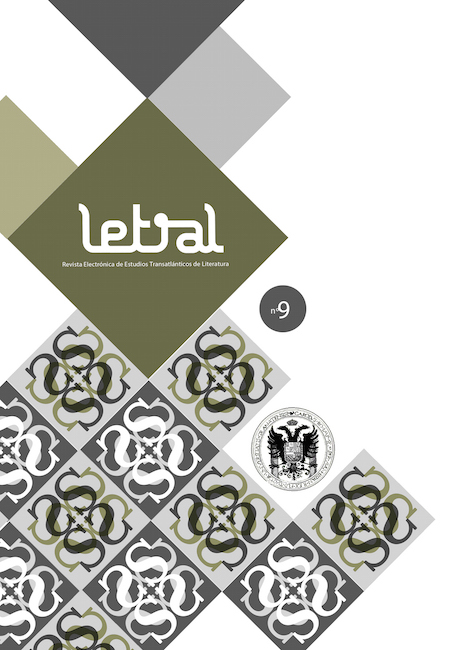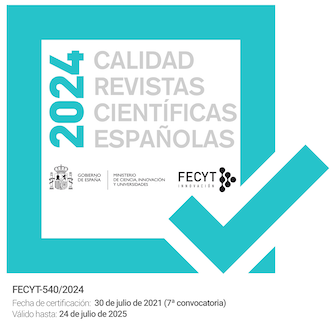De América a España: Poemas de Lida Sal de Almudena Guzmán
DOI:
https://doi.org/10.30827/rl.v0i9.3709Palabras clave:
Tercer Retorno De Las Carabelas, Boom, Literatura Iberoamericana, Puente TransatlánticoResumen
En 1981 a la edad de dieciséis años Almudena Guzmán (Navacerrada, 1964) publica su primer libro, Poemas de Lida Sal. El objetivo de este trabajo es estudiar esa obra inaugural de Guzmán como confirmación del tercer retorno de las carabelas. Emir Rodríguez Monegal identifica la época del Modernismo con el viaje emblemático de Rubén Darío a España a finales del siglo XIX como el primer retorno y la vanguardia de los años veinte y treinta como el segundo. Núria Prats Pons localiza el tercer retorno en la época inicial del boom. Es el inicio de la internacionalización de la narrativa latinoamericana. En España se vive el tercer retorno con intensidad. Prats Pons documenta la nueva abertura hacia la literatura iberoamericana utilizando varios indicios: las políticas de las editoriales, los premios literarios, la crítica en suplementos culturales y revistas literarias, participación en congresos, cursos, ferias del libro, etc. A partir de la nueva democracia el tercer retorno se transforma en un puente transatlántico de doble vía firmemente asentado.Descargas
Citas
Amorós, Andrés. Letras españolas 1976-1986. Madrid: Castalia, 1987.
Arias, Arturo. “Quetzalcóatl, la hibridación y la identidad indígena: Leyendas de Guatemala como laboratorio étnico”. En Morales, Mario Roberto (Ed.). Cuentos y Leyendas de Miguel Ángel Asturias. Madrid: ALLCA XX, Colección Archivos (2000): 625-640.
Asturias, Miguel Ángel. Cuentos y Leyendas de Miguel Ángel Asturias. Morales, Mario Roberto (Ed.). Madrid: ALLCA XX, Colección Archivos, 2000.
_____. El espejo de Lida Sal. México: Siglo XXI, 1998.
Biancotto, Natalia. “La búsqueda de una identidad hibrida en el ‘El espejo de Lida Sal’, de Miguel Ángel Asturias”. En Espéculo. Revista de Estudios Literarios 42, 2009. [ http://www.ucm.es/info/especulo/numero42/lidasal.html].
Cipliajauskaité, Biruté. “Los diferentes lenguajes de amor”. En Monographic Review/Revista Monográfica 6 (1990): 113-27.
Guzmán, Almudena. El Libro de Tamar. Melilla: Rusadir, 1989.
_____. Poemas de Lida Sal. Madrid: Puerta del Sol/Poesía, 1981.
_____. Usted. Madrid: Hiperión, 1989.
Hart, Anita. “The Relational Self in Almudena Guzman’s Dialogic Poetry”. En Rocky Mountain Review of Language and Literature 48.2 (1994) 143-160.
Prats Pons, Núria. La novela hispanoamericana en España 1962-1975. Tesis Doctoral. Universidad de Granada, 1995.
Prieto, René. “La figuración del surrealismo en las Leyendas de Guatemala”. En Morales, Mario Roberto (Ed.).Cuentos y Leyendas de Miguel Ángel Asturias. Madrid: ALLCA XX, Colección Archivos (2000): 608-624.
Rincón, Carlos. “Nociones surrealistas, concepción del lenguaje y función ideológico-literaria del ‘realismo-mágico’. Miguel Ángel Asturias”. En
Martin, Gerald (Ed.). Hombres de maíz de Miguel Ángel Asturias. Madrid: ALLCA XX/Editorial Universitaria, Colección Archivos (1997): 695-722.
Rodríguez Monegal, Emir. “El retorno de las carabelas”. En III Congreso Latinoamericano de Escritores. Caracas: Ediciones del Congreso de la República (1971): 200-206.
Sandoval, Ana María. “El espejo de Lida Sal o el reflejo de la otra realidad: lo popular híbrido en Miguel Ángel Asturias”. En Morales, Mario Roberto (Ed.). Cuentos y Leyendas de Miguel Ángel Asturias. Madrid: ALLCA XX, Colección Archivo (2000): 744-758.
Wilcox, John C. “Visión y revisión en algunas poetas contemporáneas: Amparo Amorós, Blanca Andréu, Luisa Castro y Almudena Guzmán”. En Ciplijauskaité, Biruté (Ed.). Novísimos, postnovísimos, clásicos: La poesía de los 80 en España. Madrid: Origines (1990): 95-115.
Descargas
Publicado
Cómo citar
Número
Sección
Licencia
Revista Letral es una publicación de acceso abierto e inmediato totalmente gratuita, tanto para quien lee como para quien publica. Los autores y las autoras no pagan ningún tipo de tasa por el proceso editorial de sus artículos. Permitimos la lectura, descarga, copia, distribución, impresión, búsqueda, enlace o reutilización con fines no comerciales de todos los trabajos publicados, siempre que se citen la autoría, la revista y el órgano editor. Recomendamos encarecidamente la difusión de los artículos en redes sociales (Facebook, Twitter, LinkedIn, etc.) y científicas (ResearchGate, Academia.edu, etc.), repositorios institucionales universitarios y otros repositorios públicos, blogs y webs personales o institucionales, Google Scholar, ORCID, ResearchID, ScopusID, etc. En cualquier caso, la propiedad intelectual de los artículos y los posibles derechos económicos derivados de ellos son exclusivamente de sus autores.














